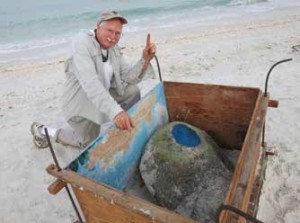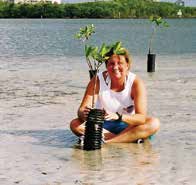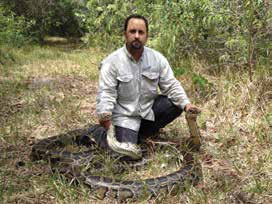Good Science Leads to Good Decision
 by Nick Penniman
by Nick Penniman
Good science leads to good decisions.”
That is Kathy Worley’s take on the work of seven scientists at the Conservancy of Southwest Florida. Worley is Director of Environmental Science, one of a long line of distinguished researchers compiling data and analyzing human impacts on the natural beauty of where we live and work.
From its very beginning, 52 years ago, the Conservancy built its reputation on pure science, independently funded and undertaken to expand human knowledge. While formed to fight the “road to nowhere” from Naples down the barrier islands to Isles of Capri, Conservancy leaders realized the best case to be made for land acquisition – now the 110,000-acre Rookery Bay National Estuarine Research Reserve – was to convince officials and the public of the economic importance of habitat for native species.
When the federal government refused to do the study, the Conservancy decided to do it. And the science division was born.
“Very few other private organizations, other than colleges and universities, continue to do the kind of independent scientific research we do,” says Worley. We are fortunate to have long-term data on areas such as Rookery Bay and Naples Bay, southwest Florida mangroves and sea turtles that will be of benefit both locally and worldwide.
 Let’s take a look at three areas of current activity by Conservancy scientists.
Let’s take a look at three areas of current activity by Conservancy scientists.
The granddaddy of all is the study of loggerhead nesting along our barrier islands. Begun in 1981, it is one of the longest-running sea turtle nesting studies in the United States. Conservancy scientists and interns have spent thousands of nights preventing nest depredation by four legged scavengers and gathering population statistics.
Shown in the photo is Dave Addison, Senior Biologist, about to release Kee Wee from her box with a satellite antenna on her shell.
The adhesive and antenna don’t hurt, and they’ll not affect her ability to swim and forage. But when she surfaces to breathe it will provide scientists a signal allowing them to create an ongoing record of her travels.
Addison, an “aw schucks” kind of guy, has been guiding this project for nearly thirty years. “It’s not only about the turtles,” he says, “but also about the formative process and about the many people who have gone on to become great researchers and great scientists.”
 Vying for longevity with the sea turtle project is Conservancy work on the mangrove forests that protect our coastline from storm surge and serve as nature’s nurseries. After all 80 percent of all fish caught, both commercially and by sport fishermen, begin their early lives in coastal estuaries.
Vying for longevity with the sea turtle project is Conservancy work on the mangrove forests that protect our coastline from storm surge and serve as nature’s nurseries. After all 80 percent of all fish caught, both commercially and by sport fishermen, begin their early lives in coastal estuaries.
This is Kathy Worley’s world. She is shown here in a photo with a small red mangrove which, once it establishes a root system, can become the precursor of a formidable island.
The Conservancy has been studying the health of mangroves in Clam Bay since 1999 to assess the overall health of the ecosystem.
The idea is to evaluate the impacts of human stressors such as dredging and urban runoff, natural events such as hurricanes and
lightning strikes and environmental factors like hydrologic variations and fungal and insect infestations. The Clam Bay mangrove study is one of the longest-running in the State of Florida.
While almost all science done by the Conservancy involves multiple partners – both government and private – not all encompasses the coastal environment.
An example of an inland study is shown in this photo of Ian Bartoszek, a Conservancy biologist who serves on the Burmese python capture team, with a thirteen foot snake. In 2015, Bartoszek tracked twelve pythons and removed twenty while obtaining valuable information about the habits of the invasive species responsible for eating much of the small prey in the Everglades ecosystem. Bartoszek’s take on the python infestation is blunt: “We aren’t going to get rid of these animals, so the best we can do is study them so we can manage the situation in the years to come.”
The future of science, according to Dave Addison, is always imponderable.
“One thing leads to another; you never know where it will take you or where it comes out. That is the nature of scientific inquiry.”

Leave a Reply
Want to join the discussion?Feel free to contribute!